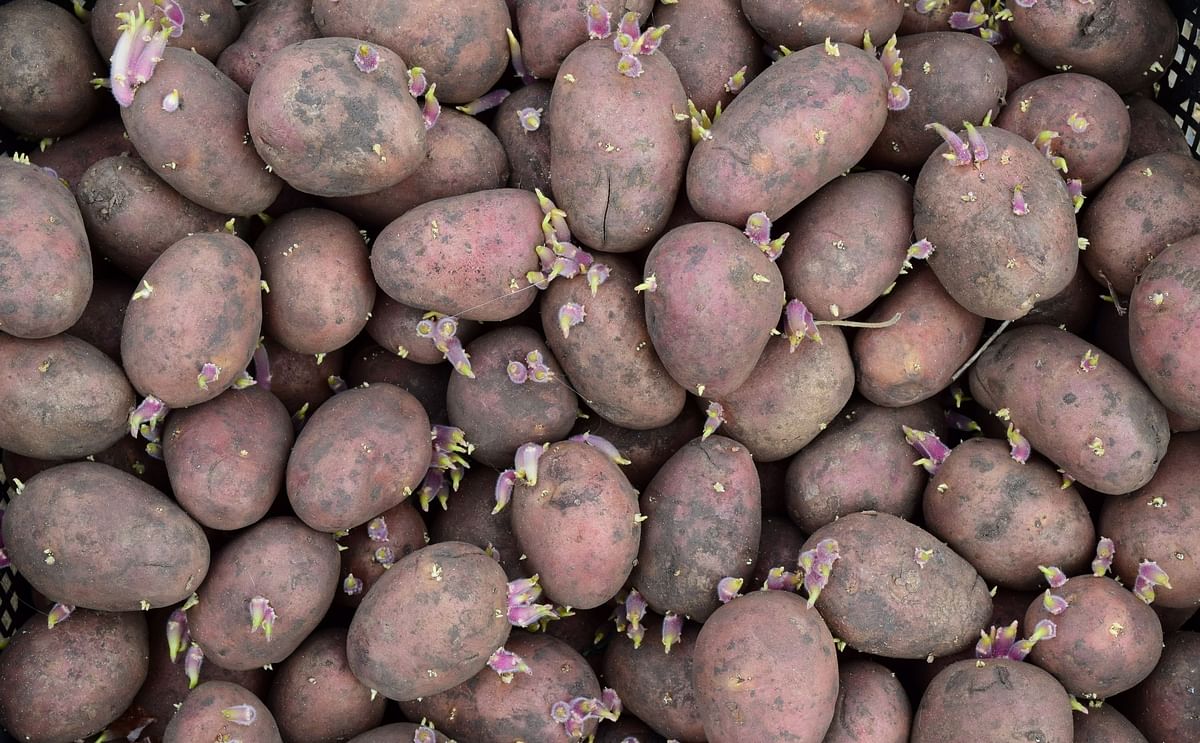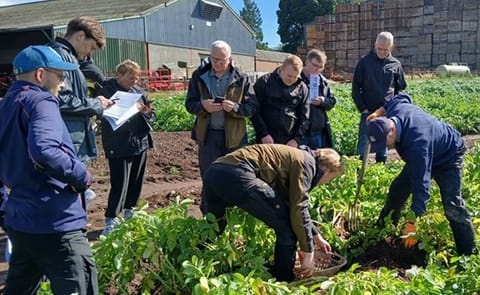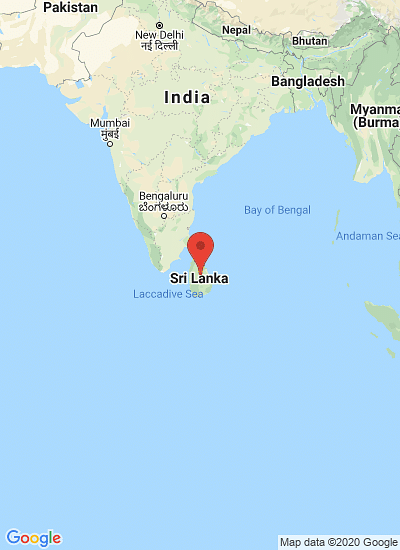Sprouted seed potatoes
How to improve the seed potato industry in Sri Lanka

Sri Lankans consume 228,000MT of potatoes annually, and the per capita consumption of potato has increased by more than five kilogrammes in the last 14 years, according to the countries statistics.
However, only 35 percent of the requirement is produced locally.
On the supply side, farmers require approximately around 15,000MT of quality seed potatoes annually to meet the production.
At present, the public sector produces 10 percent from the total seed potato requirement and another 10 percent is imported to the country. The balance 80 percent is generated by farmers themselves by reusing some of their previous crop as seed potatoes for the next year.
Potato has become an increasingly popular agricultural crop, especially among upcountry farmers, due to amplified consumer demand over the years and its shorter lifespan compared to other field crops. Both these reasons have placed potato at the top as a good cash crop in the country. With these prospects, farmers anticipate high net returns.
Unfortunately, due to the high cost of production, potato cultivation is becoming more and more challenging for farmers. For example, only the seed accounts for more than 50 percent of the total cultivation cost due to the shortage of quality seed potatoes at a reasonable price. Seed potato production begins with mini tubers and then by producing Generation 0 (G0). Since this is a technical as well as capital intensive aspect, a majority of farmers could not afford this process.
None of the private companies are involved in producing quality seed potatoes in Sri Lanka. Instead, importation of seed potatoes is solely handled by private entities. A major portion of imports arrives from the Netherlands. The US and France also contribute in lesser quantities.
Sri Lanka imports ‘Class A’ type seed potatoes to the country and according to the Dutch General Inspection Service, Class A refers to certified Generation 9 (G9) which is recommended to be cultivated only once in a season. Therefore, Class A is not recommended to generate self-seeds. The price of an imported seed box weighing 50kg is around Rs.16,000 to Rs.18,000. Interestingly, the price of a locally-produced quality seed box ranges between Rs.7,000 and Rs.10,500 depending on the certification. A farmer requires 14 to 16 seed boxes to cultivate an acre.
Inadequacy of locally-produced quality seed potatoes is a crystal clear issue in the sector. On the other hand, farmers suffer from high prices of imported seed potatoes. As a result, farmers are forced to use their seeds. Therefore, a majority of farmers depend on inferior quality seed potatoes.
Farmer-based informal seed systems are generally unable to maintain the expected quality and seeds produced through such systems are easily prone to diseases. Farmers even used to slice both local and imported seeds unnecessarily to cover the total seed requirement. This increases diseases quite frequently. Also, farmers retain some portion from the first harvest of the imported seed potatoes to use as seeds for the next season. Therefore, the ultimate result could be the reduction of total productivity at the national level, thereby creating an adverse environment for both local potato farmer and consumer communities.
In order to find out possibilities in forming public–private partnerships for quality seed potato production in Sri Lanka, the Hector Kobbekaduwa Agrarian Research and Training Institute (HARTI) conducted a research project in 2018 with the participation of both public and private entities. Neither public nor private entities could tackle this issue alone.
The formation of viable public–private partnerships for quality seed potato production in the country is an approach to overcome this issue. Sustainable agricultural production could be achieved in many ways and one such approach is viable partnerships. This has been the key success factor in countries such as India and China.
Currently, G0 production is carried out by the government sector on a large scale while a limited farmer group is involved on a small scale. However, those farmers are scattered within the major production areas. The government allocates 50 percent subsidy (50 percent cash contribution from the government and 50 percent from the farmer) for all farmers without a systematic mechanism.
Even the public sector pays minimum attention and supervision on those activities. On the contrary, it is not feasible to supervise each and every farmer at once. So, there should be a proper mechanism to allocate subsidies rather than providing them for the sake of enhancing productivity.
Even though we have a Seed Act, it has to be further strengthened to enhance local seed production and distribution. Farmers produce seeds from imported seeds and then sell it to others on a large scale without a certification.
Mostly, a good yield depends on the luck of the farmer.
At the same time, it is not feasible for commercial level private sector companies to enter into G0 production since the cost of production is comparatively higher than that of the government. For government, the cost of production is around Rs. 4.00 per G0 tuber and the market price is Rs. 6.00. However, for the private sector, the cost of production is more than Rs. 6.00 per tuber and the expected market price ranges between Rs. 10.00 and Rs. 12.00 per tuber.
Nevertheless, there is a possibility of forming partnerships related to Generation 1 (G1) seed potato production. This is a very good area for private entities to invest. Currently, the government farm located at Seetha Eliya produces G1 in 20 poly tunnels. G1 production is expected to increase by establishing another 25 poly tunnels in the farm.
This is a far better opportunity for the private sector to enter into the industry. Apart from Seetha Eliya, there are other government seed potato production farms in Meepilimana, Udaredella, Pidurutalagala and Kandapola. G1 production is feasible in those farms as well. One should clearly understand that this is not a process of privatisation of government lands. The Build-Operate-Transfer (BOT) is the ideal model for this proposal. Interestingly, if farmers are able to access locally-produced quality G1 seed potatoes, then they can reduce their per acre seed cost by 10 percent compared to imported seeds.
Yet, we do not have a proper policy initiative for public–private partnerships in the agriculture sector. Hence, both entities are pointing a finger at each other. All partnerships mutually share benefits and risks. But this has to be crafted through a proper legal agreement. Without a proper agreement, partners would not show any interest. Therefore, the proper legal environment is a must to form realistic partnerships in Sri Lanka, especially related to agriculture inputs.
However, only 35 percent of the requirement is produced locally.
On the supply side, farmers require approximately around 15,000MT of quality seed potatoes annually to meet the production.
At present, the public sector produces 10 percent from the total seed potato requirement and another 10 percent is imported to the country. The balance 80 percent is generated by farmers themselves by reusing some of their previous crop as seed potatoes for the next year.
Potato has become an increasingly popular agricultural crop, especially among upcountry farmers, due to amplified consumer demand over the years and its shorter lifespan compared to other field crops. Both these reasons have placed potato at the top as a good cash crop in the country. With these prospects, farmers anticipate high net returns.
Unfortunately, due to the high cost of production, potato cultivation is becoming more and more challenging for farmers. For example, only the seed accounts for more than 50 percent of the total cultivation cost due to the shortage of quality seed potatoes at a reasonable price. Seed potato production begins with mini tubers and then by producing Generation 0 (G0). Since this is a technical as well as capital intensive aspect, a majority of farmers could not afford this process.
None of the private companies are involved in producing quality seed potatoes in Sri Lanka. Instead, importation of seed potatoes is solely handled by private entities. A major portion of imports arrives from the Netherlands. The US and France also contribute in lesser quantities.
Sri Lanka imports ‘Class A’ type seed potatoes to the country and according to the Dutch General Inspection Service, Class A refers to certified Generation 9 (G9) which is recommended to be cultivated only once in a season. Therefore, Class A is not recommended to generate self-seeds. The price of an imported seed box weighing 50kg is around Rs.16,000 to Rs.18,000. Interestingly, the price of a locally-produced quality seed box ranges between Rs.7,000 and Rs.10,500 depending on the certification. A farmer requires 14 to 16 seed boxes to cultivate an acre.
Inadequacy of locally-produced quality seed potatoes is a crystal clear issue in the sector. On the other hand, farmers suffer from high prices of imported seed potatoes. As a result, farmers are forced to use their seeds. Therefore, a majority of farmers depend on inferior quality seed potatoes.
Farmer-based informal seed systems are generally unable to maintain the expected quality and seeds produced through such systems are easily prone to diseases. Farmers even used to slice both local and imported seeds unnecessarily to cover the total seed requirement. This increases diseases quite frequently. Also, farmers retain some portion from the first harvest of the imported seed potatoes to use as seeds for the next season. Therefore, the ultimate result could be the reduction of total productivity at the national level, thereby creating an adverse environment for both local potato farmer and consumer communities.
In order to find out possibilities in forming public–private partnerships for quality seed potato production in Sri Lanka, the Hector Kobbekaduwa Agrarian Research and Training Institute (HARTI) conducted a research project in 2018 with the participation of both public and private entities. Neither public nor private entities could tackle this issue alone.
The formation of viable public–private partnerships for quality seed potato production in the country is an approach to overcome this issue. Sustainable agricultural production could be achieved in many ways and one such approach is viable partnerships. This has been the key success factor in countries such as India and China.
Currently, G0 production is carried out by the government sector on a large scale while a limited farmer group is involved on a small scale. However, those farmers are scattered within the major production areas. The government allocates 50 percent subsidy (50 percent cash contribution from the government and 50 percent from the farmer) for all farmers without a systematic mechanism.
Even the public sector pays minimum attention and supervision on those activities. On the contrary, it is not feasible to supervise each and every farmer at once. So, there should be a proper mechanism to allocate subsidies rather than providing them for the sake of enhancing productivity.
Even though we have a Seed Act, it has to be further strengthened to enhance local seed production and distribution. Farmers produce seeds from imported seeds and then sell it to others on a large scale without a certification.
Mostly, a good yield depends on the luck of the farmer.
At the same time, it is not feasible for commercial level private sector companies to enter into G0 production since the cost of production is comparatively higher than that of the government. For government, the cost of production is around Rs. 4.00 per G0 tuber and the market price is Rs. 6.00. However, for the private sector, the cost of production is more than Rs. 6.00 per tuber and the expected market price ranges between Rs. 10.00 and Rs. 12.00 per tuber.
Nevertheless, there is a possibility of forming partnerships related to Generation 1 (G1) seed potato production. This is a very good area for private entities to invest. Currently, the government farm located at Seetha Eliya produces G1 in 20 poly tunnels. G1 production is expected to increase by establishing another 25 poly tunnels in the farm.
This is a far better opportunity for the private sector to enter into the industry. Apart from Seetha Eliya, there are other government seed potato production farms in Meepilimana, Udaredella, Pidurutalagala and Kandapola. G1 production is feasible in those farms as well. One should clearly understand that this is not a process of privatisation of government lands. The Build-Operate-Transfer (BOT) is the ideal model for this proposal. Interestingly, if farmers are able to access locally-produced quality G1 seed potatoes, then they can reduce their per acre seed cost by 10 percent compared to imported seeds.
Yet, we do not have a proper policy initiative for public–private partnerships in the agriculture sector. Hence, both entities are pointing a finger at each other. All partnerships mutually share benefits and risks. But this has to be crafted through a proper legal agreement. Without a proper agreement, partners would not show any interest. Therefore, the proper legal environment is a must to form realistic partnerships in Sri Lanka, especially related to agriculture inputs.
Recommendations
- Sri Lanka should strengthen the Seed Act and should have a clear approach and strategic guidelines to form a public–private partnership in the seed sector.
- G0 production should be mainly carried out by the government sector.
- G0 production could be strengthened by extending it only to a selected farmer group.
- Effective supervision, technical knowhow and 50 percent subsidy on G0 production should be provided only to those farmer groups.
- Private sector companies should not be involved in G0 production since it is not economically feasible for them.
- The private entity could enter into local production by focusing on G1 seed potato production.
- The formation of a BOT (Build-Operate-Transfer) agreement is the ideal solution to expand the production of quality seed potatoes in Sri Lanka.
- Under the BOT approach, the government should provide land as the key resource and the private entity should receive a concession for a fixed period for the development and operation of the given plot of land.
- The development consists of the financing, designing and constructing of the facility, managing and maintaining the facility adequately, and making it sufficiently profitable.
- The private entity should utilise the land to strengthen the production of G1 seed potatoes in poly tunnels under the aeroponic system.
- At the end of the concession period, the private entity should transfer the ownership of the facility free of liens to the public entity at no cost.
- G1 seed potatoes should be disseminated among farmers. Then, farmers could rotate cultivation for two or three seasons with the use of self-seeds. This would greatly reduce the cost of cultivation.
- Cold storage facilities should only be constructed for large-scale and active farmer groups and maintenance including utility cost should be transferred to the specific farmer group to make it a realistic investment. Capacity ranging from 50MT to 100MT is more than adequate for this purpose.
- Seed potato importation should be kept as it is, since Sri Lanka has authority to multiply only one variety (Granola) for commercial purposes.
Like to receive news like this by email? Join and Subscribe!
Get the latest potato industry news straight to your WhatsApp. Join the PotatoPro WhatsApp Community!
Sponsored Content
Sponsored Content
Sponsored Content
Sponsored Content






